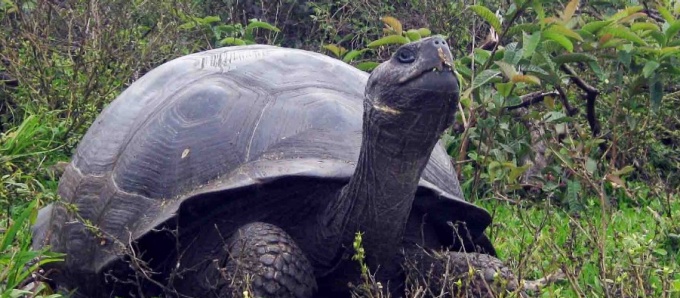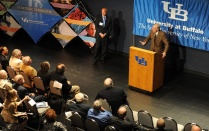Lynch Lab analyzes gene duplication to translate research discoveries into benefits for human health and wellness

“In the Lynch Lab, we can stress the cells out in ways that are associated with aging and see how well they resist that distress. And it turns out that the Galápagos tortoise cells are really, really good at killing themselves before that stress has a chance to cause diseases like cancer,” says evolutionary biologist Vincent Lynch. Assistant Professor, Biological Sciences. One major focus of Lynch’s work is understanding the biological mechanisms that help big animals like Galápagos tortoises live long and prosper. The research is driven by simple curiosity. But the findings could have practical implications, too. Read the news release by Charlotte Hsu.
UB NEWS CENTER
Live long and prosper: Study examines genetic gems in Galápagos giant tortoise genomes
Galápagos tortoises. Credit: Ylenia Chiari
These big turtles have extra copies of genes that may help them age well and evade cancer, and the creatures’ cells respond to stress in ways that may help to prevent disease, scientists conclude
Release Date: November 18, 2021
BUFFALO, N.Y. — Galápagos giant tortoises can weigh well over 300 pounds and often live over 100 years. So what’s the secret to their evolutionary success?
A new study concludes that compared with other turtles, these animals evolved to have extra copies of genes — called duplications — that may protect against the ravages of aging, including cancer.
Laboratory tests on Galápagos giant tortoise cells corroborate the idea that the animals have developed such defenses, says Vincent Lynch, an evolutionary biologist at the University at Buffalo.
Specifically, experiments showed that the creatures’ cells are super sensitive to certain types of stress relating to damaged proteins. When exposed to these pressures, the cells self-destruct much more readily than other turtle cells through a process called apoptosis, the research found. Destroying glitchy cells before they have the chance to form tumors could help the tortoises evade cancer, Lynch says.
“In the lab, we can stress the cells out in ways that are associated with aging and see how well they resist that distress. And it turns out that the Galápagos tortoise cells are really, really good at killing themselves before that stress has a chance to cause diseases like cancer,” says Lynch, PhD, associate professor of biological sciences in the UB College of Arts and Sciences.
The study was published on Nov. 18 in Genome Biology and Evolution. The findings both confirm and build on results of past research, such as a 2018 study by another team that also used genetic analyses to explore longevity and age-related disease in giant tortoises.
Study first author Scott Glaberman.
Study co-author Ylenia Chiari.
Authors of the new paper in Genome Biology and Evolution include Lynch; Galápagos giant tortoise experts Scott Glaberman, PhD, and Ylenia Chiari, PhD, at George Mason University; Stephanie Bulls at the University of South Alabama, now at George Mason University; and Juan Manuel Vazquez, PhD, at the University of California, Berkeley.
Study co-author Stephanie Bulls.
Study co-author Juan Manuel Vazquez.
The findings are particularly intriguing because — all things being equal — huge animals that live for a long time should have the highest cancer rates. That’s because big, long-lived things have many more cells, and the more cells a body has, the more opportunities there are for cancerous mutations to arise.
One major focus of Lynch’s work is understanding the biological mechanisms that help big animals like Galápagos tortoises live long and prosper. (His team explored this question in elephants in a 2021 study). The research is driven by simple curiosity. But the findings could have practical implications, too.
A Galápagos tortoise. Credit: Ylenia Chiari
“If you can identify the way nature has done something — the way certain species have evolved protections — maybe you can find a way to translate those discoveries into something that benefits human health and disease,” Lynch says. “We’re not going to go treating humans with Galápagos tortoise genes, but maybe we can find a drug that mimics certain important functions.”
Research of this kind also underscores the value of conservation.
“Studies like this demonstrate why preserving biodiversity is so important,” says Glaberman, the paper’s first author and an assistant professor of environmental science and policy at George Mason University. “Extreme species like Galápagos giant tortoises probably hold many secrets for dealing with major human challenges like aging and cancer, and even climate change. Our study also shows that even within turtles, different species look, act and function differently, and losing any species to extinction means that a piece of unique biology will be lost to the world forever.”
A Galápagos tortoise. Credit: Ylenia Chiari
Media Contact Information
Charlotte Hsu is a former staff writer in University Communications. To contact UB's media relations staff, email ub-news@buffalo.edu or visit our list of current university media contacts.
Faculty Profile
![Vincent J. Lynch, PhD.]()
Vincent J. Lynch
PhD
Research Interests
Genetics, Genomics and Systems Biology; Evolutionary Biology.
Education
PhD, Ecology and Evolutionary Biology, Yale University, 2008
MS, Ecology and Evolutionary Biology, Yale University, 2005
BS, Biology and Anthropology, University at Albany, SUNY, 2002
Office Hours
Contact vjlynch@buffalo.edu
Research Summary
A major challenge in biology is to determine the genetic and molecular mechanisms responsible for phenotypic differences between species (DevoEvo), particularly mechanisms that underlie the origin of new anatomical structures (‘evolutionary novelties’), biological functions (‘evolutionary innovations’), and that limit biological possibilities (‘developmental constraints’). To explore how evolutionary novelties, innovations, and developmental constraints evolve we combine comparative genomics and experimental methods to deduce the molecular mechanisms that underlie the evolution of pregnancy and animals with extremely long lifespans and large body sizes, and the role evolutionary history plays in our susceptibility to diseases such as preterm birth and cancer.
Current Project
Evolutionary mechanics of adhesion complexes that mediate Amniote hearing
Selected Publications
- VJ Lynch Relaxed constraint and functional divergence of the progesterone receptor (PGR) in the human stem-lineage M Marinić, , PLoS Genetics 16 (4), e1008666
- E Fry, SK Kim, S Chigurapti, KM Mika, A Ratan, A Dammermann, Brian J. Mitchell, Webb Miller, Vincent J Lynch (2020) Functional architecture of deleterious genetic variants in the genome of a Wrangel Island mammoth. Genome Biology and Evolution 12 (3), 48-58
- JM Vazquez, VJ Lynch. Pervasive duplication of tumor suppressors in Afrotherians during the evolution of large bodies and reduced cancer risk. bioRxiv
- M Marinic, K Mika, S Chigurupati, VJ Lynch, Evolutionary transcriptomics implicates HAND2 in the origins of implantation and regulation of gestation length. bioRxiv
- Erin Fry, Sun K. Kim, Sravanthi Chigurapti, Katelyn M. Mika, Aakrosh Ratan, Alexander Dammermann, Brian J. Mitchell, Webb Miller, Vincent J. Lynch (2020) Functional architecture of deleterious genetic variants in the genome of a Wrangel Island mammoth. Genome Biology and Evolution, evz279.
- Vazquez JM, Sulak M, Chigurupati S, Lynch VJ (2018) A Zombie LIF Gene in Elephants Is Upregulated by TP53 to Induce Apoptosis in Response to DNA Damage. Cell Rep. 24(7):1765-1776.
- Sulak M, Fong L, Mika K, Chigurupati S, Yon L, Mongan NP, Emes RD, Lynch VJ (2016) TP53 copy number expansion is associated with the evolution of increased body size and an enhanced DNA damage response in elephants. Elife. 5: e11994.
- Lynch VJ, Nnamani MC, Kapusta A, Brayer K, Plaza SL, Mazur EC, Emera D, Sheikh SZ, Grützner F, Bauersachs S, Graf A, Young SL, Lieb JD, DeMayo FJ, Feschotte C, Wagner GP (2015) Ancient transposable elements transformed the uterine regulatory landscape and transcriptome during the evolution of mammalian pregnancy. Cell Rep. 10(4):551-61.









